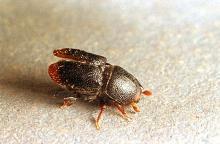Includes
Ambrosia beetle (Xyleborinus spp.)
Shothole borer (Scolytus rugulosus)
Pest description and crop damage Shothole borers are small beetles that were introduced to North America and have been found in the PNW since the early 1900s. They are pests of forest trees, ornamental shade trees, and shrubs as well as fruit trees. Apple, pear, cherry, and plum are attacked. Borers are primarily a problem on injured or stressed plants, but healthy trees growing adjacent to blocks of neglected trees or infested woodpiles may be attacked. The adult shothole borer is a brownish black beetle are less than 0.1 inch in length. Larvae are white, legless, and about 0.17 inch in length. A similar wood-boring beetle, the ambrosia beetle, is about 0.1 inch in length, dark brown or black, cigar-shaped, and covered with yellowish hairs. Larva is pinkish-white, legless, cylindrical, and 0.17 inch in length when mature. Larvae and adults of both these species bore into the cambial and vascular tissues of trees, weakening them and causing wilting and dieback of individual stems and branches. Trunks and branches can be completely riddled with galleries.
Biology and life history Shothole borer overwinters as a larva in burrows beneath the bark of infested trees. They pupate within the tree, then adults emerge in spring or early summer, mate, and fly to susceptible trees to feed at the base of leaves or small twigs. Then they tunnel into the tree, excavating galleries parallel to the wood grain. Adults mate and lay eggs along the gallery. The eggs hatch, and the larvae feed by tunneling at right angles to the main burrow, causing a characteristic pattern of damage. The burrows are filled with frass and increase in diameter as the larvae mature. After 6 to 8 weeks, the larvae pupate at the ends of the galleries, then emerge as adults starting in August. The many small, round exit holes this creates gives a "shothole" effect. There are two generations per year.
The ambrosia beetle overwinters as a mature larva, pupa, or adult in galleries in the tree. When spring temperatures exceed 65° F, the females become active, fly to susceptible hosts, and bore into the tree. Eggs are laid in the gallery, and as they develop, the female carefully tends them and cultivates ambrosia fungus for them to eat. Females usually remove excrement or wood dust from the tunnels, and this, along with the uniform width of the galleries, distinguishes them from other wood-boring beetles. Young adults can be found tightly packed in the galleries in midsummer, where they remain until the following spring. There is only one generation per year.
Pest monitoring Periodically scout tree trunks and lower branches for presence of adult beetles, particularly between June to July and between September and October. Examine branches in late spring for holes 0.08 inch in diameter that often ooze sap and sawdust. These beetles are particularly attracted to unhealthy trees.
Management-cultural control
Maintain trees in vigorous condition and avoid water stress or trunk sunburn. Borer attack usually indicates that trees are stressed. Prune out shothole borer damaged limbs and destroy or burn all tree prunings that show signs of borer damage. Do not plant (or transplant) young fruit trees adjacent to wood piles, tree prunings, or other borer-infested trees.
Management-chemical control
Chemical controls are of limited value towards adults and ineffective towards larvae. Chemical controls can be directed towards adults as direct trunk or limb sprays when adult beetles are present.
Management-chemical control: HOME USE
- pyrethrins-Highly toxic to bees. Some formulations are OMRI-listed for organic use.
Management-chemical control: COMMERCIAL USE
Spring and summer sprays
Check product labels for use on peaches.
- acetamiprid (Assail 30SG) at 8 oz/A. REI 12 hr. PHI 7 days.
- esfenvalerate (Asana XL) at 14.5 fl oz/A. REI 12 hr. PHI 14 days.




